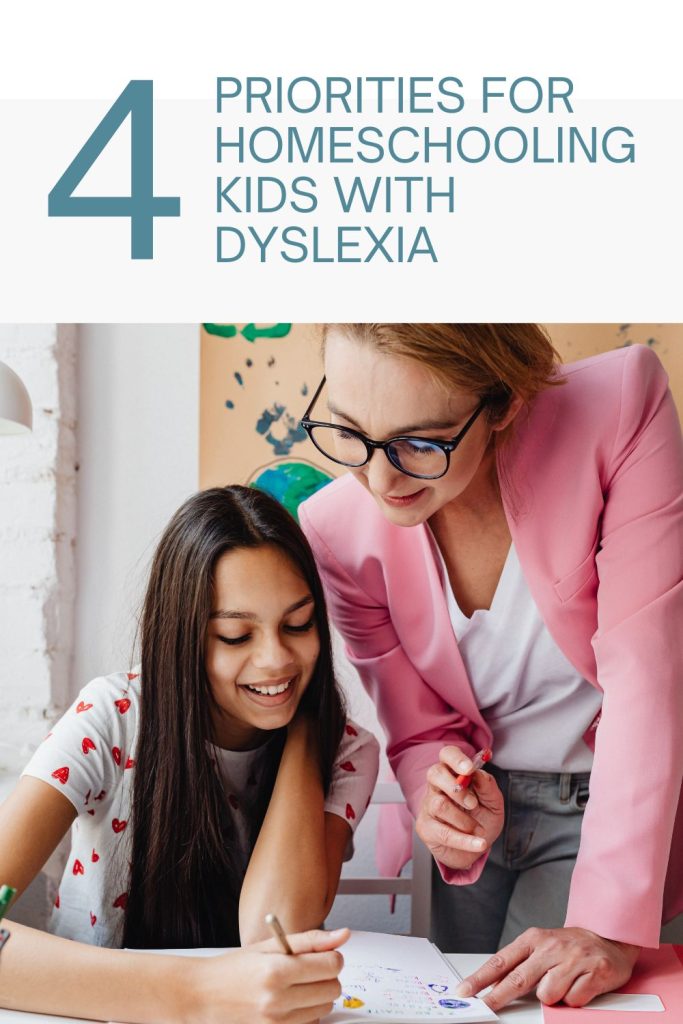After homeschooling kids with dyslexia for nearly 30 years and now having graduated 5 of them from high school, here are a few things I’ve learned are priorities for homeschooling kids with dyslexia.

Teach them at their level. You are not behind!
One of the reasons why traditional schools do not work well for our kids with dyslexia is because the teaching is not individualized. In other words, when 80% of kids in class have mastered whatever is being taught, the teacher moves on to the next lesson.
However, many of our kids will need many chances to review and practice a concept before mastery is reached. This applies especially to any kind of language-based learning; reading, writing, and spelling. Dyslexia is, after all, a language-based learning difficulty.
One of the beautiful freedoms we have as homeschoolers is that we can teach our kids to mastery; meaning, we can teach them the same spelling words until they are mastered as opposed to failing a spelling test one week and getting a whole new list of words the next week.
Note: You should not be giving spelling tests to your dyslexic kids in your homeschool.
For more on how to teach spelling, read this.
If you are worried about your kids being behind, read this to learn why grade levels were created and why they aren’t important to you as a homeschooler.
Use methods that work as consistently as possible.
There are specific methods of teaching that work better with kids with dyslexia. Specifically, our teaching should be:
Teaching Kids With Dyslexia: Individualized
I often tell parents who are teaching their kids at home to think of themselves as a tutor. A tutor doesn’t just press on through curriculum without considering the needs of his or her student. A tutor will notice an area of need in a child’s learning and tailor the teaching to meet those needs. This is the essence of individualized teaching.
Teaching kids with dyslexia: Multi-sensory
Research has shown that the more senses you use at the same time, AKA multi-sensory learning, the better the information being taught sticks in the brain. This makes sense if you consider that seeing, hearing, and touching information sends information to different areas of the brain. This doesn’t just apply to reading as in the Orton-Gillingham method. This applies to all areas of learning and teaching, not just reading.
Teaching kids with dyslexia: Explicit
One of the tenants of the Orton-Gillingham approach to teaching reading is that the teaching should be explicit. This means that you don’t leave anything to chance or assume kids will pick up on it without being taught. A research-based reading program will never assume a child knows something that hasn’t been specifically, or explicitly, taught.
To learn more about the Orton-Gillingham approach to teaching, read this.
Look for where their strengths and interests intersect.
I have a unique perspective as a long time homeschooling mom. I have an opportunity, now that I have graduated six of my kids, to be able to look back and see what was useful and what was not so useful.
Not useful:
Worrying that they will never read well. They will.
Trying to get them to learn more like a traditional learner. Not going to happen.
Ignoring their strengths and focusing on their weaknesses. Their weaknesses actually result in some pretty impressive strengths.
What took my by surprise as I have watched my homeschooled kids with dyslexia and ADHD graduate from high school and move on into adulthood is that as they found their ‘thing’ – something that they were super excited to pursue career-wise, they became extremely motivated.
They worked hard without me nagging them because they wanted to reach their goal.
From what I can see, this happened for a few reasons:
They understood themselves. A big part of teaching kids who learn differently at home is teaching them to understand their learning strengths and weaknesses and how to advocate for themselves.
Learn more about how to teach kids to advocate for themselves here.
They remained curious. Fostering curiosity in our kids is critical. Curious kids and teens are willing to explore their world and enjoy new experiences.
Kids who understand their learning strengths and weaknesses and who are curious about the world around them have the confidence to go out and pursue things that they are interested in.
Where their interests and abilities intersect is where they will find deep satisfaction in their work and lives; even if they have to work hard to achieve it.
Prioritize your relationship.
More and more as my kids grow older, I realize the importance of maintaining an open and accepting communication style with them.
Listening to our kids and reflecting back what they are saying.
Understanding that sometimes there is more behind their words than meets the eye.
Being curious about what our kids are experiencing and helping them to understand themselves.
All of these things are possible because we have a relationship with them unlike any other. While homeschooling can be hard at times and intense and maybe overwhelming, the flip side of that is that we know our kids better than most parents. Obviously, this can be a blessing and a curse.
Looking back, I can see where maintaining good communication and a loving relationship with our kids allows us to speak into their lives which is helpful for them and deeply satisfying for us as parents.






0 Comments